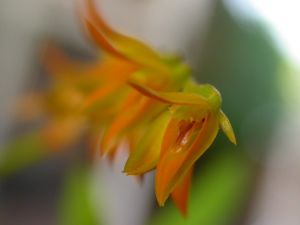No edit summary |
No edit summary |
||
| Line 1: | Line 1: | ||
[[File:Pleurothallis_glumacea.jpg|thumb|''Pleurothallis glumacea'']] | [[File:Pleurothallis_glumacea.jpg|thumb|''Pleurothallis glumacea'']] | ||
'''Code:''' PTHS.0x0005 | |||
'''Common Name:''' The Glumacious Pleurothallis<br /> | '''Common Name:''' The Glumacious Pleurothallis<br /> | ||
Revision as of 00:12, 3 January 2011

Code: PTHS.0x0005
Common Name: The Glumacious Pleurothallis
Scented: no
Light Requirements: deep shade
Temperature Requirements: cool to intermediate
Bloom: summer and again in autumn
Flower Size: 1.9cm
Synonyms: Acianthera glumacea (Lindl.) Pridgeon & M.W.Chase 2001; Humboldtia glumacea (Lindl.) Kuntze 1891; Pleurothallis alexandrae Schltr. 1922; Pleurothallis alexandrae Schltr. 1923; Pleurothallis crocea Barb.Rodr. 1881; Pleurothallis glaziovii Cogn. 1896; Pleurothallis vitellina Porsch 1905
Found in Southern and South-Eastern Brazil on rough mossy bark in primary forests at elevations of 1300m as a miniature sized, warm to cool growing epiphyte with an erect ramicaul carrying a single apical, erect, coriaceous, oblanceolate, acute, gradually narrowing below into the stout, petiolate base leaf that blooms in the spring through fall on 2 to 3 at once, racemose, 6cm long, 4 to 9 flowered inflorescence arising from the apex of the ramicaul and can bloom for several years with new inflorescence from the same ramicaul.
{{
- display_points:
service=googlemaps3 |address=-20.13847, -43.945312~South-Eastern Brazil; -25.021903, -51.416016~Southern Brazil |type=terrain |types=satellite,terrain |height=350 |width=550 |autozoom=off |zoom=4 |controls=type }}